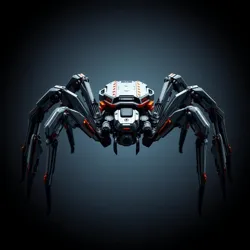Synthetic Arachnids

Synthetic Arachnids are sophisticated biomechanical organisms that combine advanced robotics with arachnid-inspired design. First developed in 2158 by Octopod Industries, these artificial life forms serve crucial roles in surveillance, maintenance, and defense operations across various sectors.
Design and Structure
Synthetic Arachnids feature quantum-crystalline exoskeletons integrated with advanced sensor arrays and powered by miniaturized thoracic fusion cores. Their eight legs incorporate nano-scale hydraulics that enable precise movement and force control, while specialized spinnerets produce high-tensile synthetic fiber for various applications.
Key Components
- Neural processing matrix
- Multi-spectrum sensor array
- Molecular adhesion pads
- Quantum motion processors
- Self-repairing nanite colonies
Classifications
Military Units
- Spider Infiltration Units - Stealth and reconnaissance
- Scorpion Defense Units - Perimeter security
- Tarantula Heavy Assault Units - Combat operations
Industrial Models
- Maintenance drones
- Construction units
- Inspection systems
Applications
Security Operations
Synthetic Arachnids excel in surveillance and security roles, utilizing their ability to navigate complex three-dimensional spaces and deploy sophisticated sensor networks. Many facilities employ Arachnid Security Grids for comprehensive protection.
Infrastructure Maintenance
These units perform critical maintenance tasks in hazardous or hard-to-reach areas, including: - Power plant inspection - Bridge maintenance - Tunnel system monitoring
Recent Developments
Current research focuses on enhancing swarm coordination protocols and developing more sophisticated web-weaving capabilities for construction applications. Advanced models now incorporate quantum sensing arrays for improved threat detection and environmental analysis.
See Also
- Biomechanical Warfare Systems
- Synthetic Silk Production
- Quantum Arachnid Intelligence
References
- Journal of Synthetic Biology
- Advanced Robotics Quarterly
- Biomechanical Engineering Review